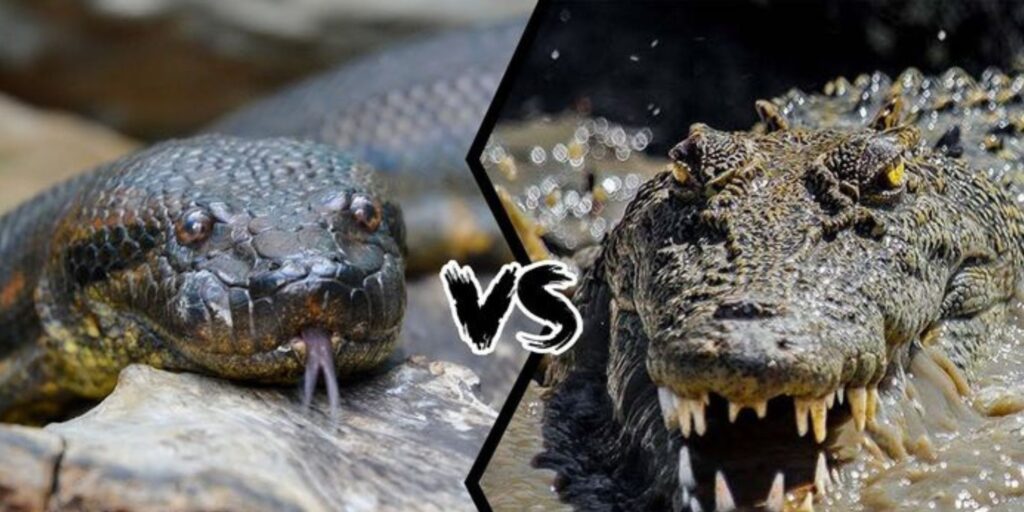Overview
Anacondas and crocodiles are two of the most powerful predators in the animal kingdom. They both dominate their ecosystems. Anacondas are massive snakes, while crocodiles are fierce reptiles. The question remains: Can Anacondas Eat Crocodiles ? This article explores this intriguing question, diving into the behavior and physical abilities of both predators.
The Size and Strength of Anacondas

The green anaconda (Eunectes murinus) is the largest snake in the world by weight. It can grow over 30 feet long and weigh more than 500 pounds. Anacondas live in swamps, marshes, and slow-moving rivers in South America. They are excellent swimmers and rely on stealth to hunt. Anacondas can prey on large animals, including fish, birds, and even caimans. After catching their prey, they constrict around it. The pressure from the constriction eventually kills the animal, and the snake swallows it whole. Anacondas can consume prey larger than their head because their jaws can stretch.
The Size and Strength of Crocodiles: Can Anacondas Eat Crocodiles
Crocodiles, especially saltwater and Nile crocodiles, are some of the largest reptiles on Earth. A saltwater crocodile can grow up to 23 feet long and weigh more than 2,000 pounds. These predators have incredibly powerful jaws. Their bite force exceeds 3,000 psi, the strongest of any animal. Crocodiles are ambush hunters. They wait patiently for prey to come near the water’s edge before launching a sudden attack. After capturing their prey, they drag it into the water to drown it. Crocodiles then swallow their food whole, using their flexible jaws.
Overlapping Habitats of Anacondas and Crocodiles
Anacondas and crocodiles share similar habitats. They both live in tropical wetlands, rivers, and marshes. Anacondas typically dwell in the Amazon Basin, while crocodiles can be found in similar regions across Africa, Asia, and Australia. In South America, the green anaconda and caimans, a type of crocodilian, can sometimes be found in the same area. While both are apex predators, they do not often cross paths. This is because anacondas hunt at night, and crocodiles are usually more active during the day.
Can an Anaconda Constrict a Crocodile?
Anacondas are strong constrictors. They kill their prey by wrapping around it and squeezing until the prey suffocates. Can an anaconda use this method on a crocodile? The crocodile’s thick, armored skin presents a challenge. Even though anacondas can take down large animals, the hard exterior of a crocodile could make it difficult to get a proper grip. Additionally, crocodiles are highly aggressive. Their sharp teeth and strong tail make them dangerous to any predator that tries to attack them. While an anaconda may be able to immobilize a smaller crocodile or caiman, the thick hide of an adult crocodile could prevent a successful strike.
Could an Anaconda Swallow a Crocodile?
Anacondas can consume animals larger than their heads. Their jaws can stretch wide enough to allow them to swallow large prey. However, swallowing a crocodile would be another matter. Crocodiles are heavy and rigid. Anacondas typically prey on animals that are more flexible, such as caimans or capybaras. A crocodile’s tough, scaly skin would be hard for the snake to grip. Moreover, the crocodile’s body is often too large for the anaconda to swallow comfortably. A crocodile’s size and the thickness of its body would make it a difficult meal for an anaconda.
The Risks to Anacondas: Can Anacondas Eat Crocodiles
Anacondas are skilled hunters, but they face serious risks when engaging with large animals. Crocodiles are extremely dangerous. They have powerful jaws and sharp teeth that can inflict serious injuries. An anaconda attempting to capture a crocodile would be vulnerable to a bite. Additionally, crocodiles can use their tails to strike back at predators. An anaconda’s typical strategy of constricting prey might not work if the crocodile fights back effectively. Anacondas tend to avoid confrontations with dangerous animals, as the risk of injury is too high.
Documented Encounters Between Anacondas and Crocodiles
There are few documented cases of anacondas attacking adult crocodiles. In the wild, when an anaconda and a crocodile do encounter one another, they generally avoid confrontation. Anacondas prefer to hunt animals like capybaras or smaller caimans, which are easier to subdue. Crocodiles, meanwhile, are known for their territorial nature. They often react aggressively to threats in their environment. As a result, an anaconda is unlikely to try to eat an adult crocodile. It is more likely to avoid it or target smaller prey instead.
Conclusion: Can Anacondas Eat Crocodiles

While anacondas are capable of eating large animals, the size, strength, and defensive abilities of crocodiles make them a difficult and unlikely target. The crocodile’s tough skin and powerful defenses would pose significant challenges for an anaconda. It is unlikely that an anaconda could successfully constrict and swallow an adult crocodile. Both animals are apex predators, but their encounters in the wild are rare, and when they do occur, they usually avoid conflict. In the end, an anaconda would likely steer clear of a crocodile, preferring to hunt easier prey.
Anacondas and Crocodiles: Apex Predators of Different Environments
Anacondas and crocodiles dominate different ecosystems. Anacondas live primarily in freshwater swamps, marshes, and rivers of South America. Crocodiles, on the other hand, inhabit a broader range of environments, including riverbanks, estuaries, and coastal regions. Both species, though highly skilled hunters, thrive in their respective domains. Anacondas have evolved to ambush prey in the dense, murky waters of the Amazon, while crocodiles use their swift ambush techniques to capture unsuspecting animals that venture too close to their territory.
Despite their overlapping habitats in some regions, anacondas and crocodiles rarely come into direct conflict. Their hunting times, behavior, and physical differences keep them mostly apart. While anacondas are more likely to focus on smaller, less defensive prey, crocodiles remain territorial and aggressive, seeking to protect their domain.
The Physical Differences Between Anacondas and Crocodiles: Can Anacondas Eat Crocodiles
Anacondas and crocodiles are powerful in their own right. However, their physical traits make it difficult for them to interact in a way where one would overpower the other. The anaconda’s strength lies in its ability to constrict, using its muscular coils to squeeze the life out of its prey. On the other hand, a crocodile’s strength comes from its immense bite force. The crocodile’s jaws can snap shut with incredible force, often overpowering the prey with a single strike.
Crocodiles have thick, armored skin, which protects them from many threats. This tough hide is difficult for any predator to penetrate. Anacondas, while strong, rely on constriction to kill their prey, and the crocodile’s armor offers significant resistance to this method. The result is that anacondas typically avoid challenging the formidable defenses of crocodiles.
Why Anacondas Avoid Large Prey Like Crocodiles

Anacondas are skilled hunters, but they prefer to take on prey that is manageable. While they can bring down large animals like capybaras and caimans, they avoid prey that poses a significant risk to their health. Crocodiles are highly dangerous, especially if they are fully grown. Their strength, speed, and aggression make them difficult to overpower. An anaconda that attempts to attack a crocodile could find itself seriously injured, and this risk is not worth the reward. For an anaconda, smaller, less dangerous prey provides an easier and safer hunting experience.
The Role of Size in Predatory Interactions
The size of both anacondas and crocodiles plays a critical role in whether one predator can overpower the other. While anacondas can grow to massive lengths, crocodiles tend to be heavier and more muscular. A fully grown crocodile’s size and strength make it nearly impossible for an anaconda to tackle. In contrast, smaller crocodiles, such as juveniles or caimans, could potentially become prey for an anaconda due to their less formidable size and limited defense mechanisms.
For an anaconda to successfully prey on a crocodile, it would need to find a smaller, vulnerable one. Adult crocodiles, however, remain out of reach for most anacondas due to their powerful defense mechanisms.
The Risks of Confrontation Between Apex Predators
In nature, predators rarely engage in unnecessary combat. Both anacondas and crocodiles are apex predators, meaning they have few threats to worry about in their environments. Engaging in conflict with one another could lead to severe injury or death, making such confrontations highly unlikely. When they do occur, both animals tend to avoid direct conflict, opting for more strategic means of survival. An anaconda will often retreat when it encounters a crocodile, recognizing that the risk of injury is too high. Similarly, a crocodile may back off from a large anaconda, understanding that engaging could be costly.
Conclusion: Mutual Avoidance in the Wild
Despite the power and hunting prowess of both anacondas and crocodiles, these two apex predators prefer to avoid direct confrontations. Their physical differences, territorial behavior, and hunting strategies ensure that their encounters remain rare. Anacondas focus on more manageable prey, while crocodiles defend their territories aggressively. As a result, it is highly unlikely that an anaconda would ever attempt to eat a crocodile, especially a fully grown one. In the wild, both predators thrive in their environments, and mutual avoidance ensures their continued dominance in their respective ecosystems.



